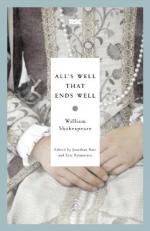|
This section contains 5,505 words (approx. 19 pages at 300 words per page) |

|
SOURCE: “All's Well That Ends Well and the Limits of Comedy,” in ELH, Vol. 52, No. 3, Fall, 1985, pp. 575-89.
In the following essay, Kastan explores the problematic view of comedy presented in All's Well That Ends Well.
Renaissance theories of comedy generally stress its moral function: “Comedy is an imitation of the common errors of our life,” says Sidney, which the comic poet “represents in the most ridiculous and scornful sort that may be, so as it is impossible that any beholder can be content to be such a one.”1 Comedy, then, is at once critical and corrective, holding the mirror up to degenerate nature so that the viewer may see and repudiate its images of human folly.
Thomas Heywood similarly conceives comedy's function:
either in the shape of a clown to shew others their slovenly and unhandsome behaviour, that they may reforme that simplicity in themselves which others...
|
This section contains 5,505 words (approx. 19 pages at 300 words per page) |

|


